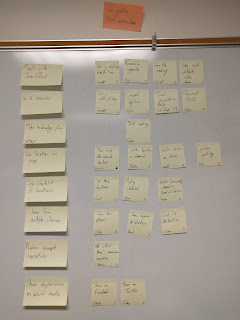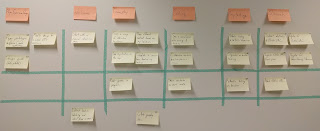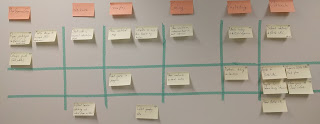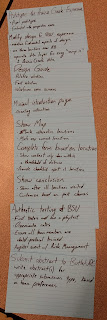About a year ago,
I wrote about how my first attempt with story mapping did not go as well as I had hoped and that
my team eventually abandoned them. Last semester, I decided to invest some time in building a better understanding of the technique, so I did what any reasonable contemporary developer would do: I bought and read
Jeff Patton's book. One of the key insights I got from this book—perhaps something that's obvious to regular practitioners, but I didn't see at the time—is that story maps can replace one-dimensional backlogs but not Scrum-style task boards. That is, while the story map provides the big picture of the project plan, teams still need other modes for tracking smaller-grain tasks. Among other factors, this made me want to revisit story maps in Spring, and so I have.
This semester, I am once again leading a multidisciplinary undergraduate team in an immersive learning project. I wrote a bit about the project when
I wrote about sustainability game design and
the conclusion of my game design colloquium. This semester, my team is building a Web-based, geolocative, educational game to complement the educational themes of
Camp Prairie Creek. We just wrapped up our first sprint, which resulted in the team building a proof-of-concept experience using
Polymer while exploring various narrative themes. Before the sprint, I had laid out a story map based on my vision for the project, and the team had some input into the overall shape of it.
 |
| Sprint 1 Story Map |
During sprint planning, the team decided where to slice it. We took the stories for this first experimental sprint and transcribed them onto new cards for the task board.
 |
| Task Board at the start of Sprint 1 |
The sprint ended this past Friday, and although not every task was complete, we deemed it a success: the team was able to learn the fundamentals of Polymer, including building fluency with command-line git; we have a technical artifact that shows how various pieces fit together; and we have a more coherent vision for a narrative structure and theme. However, throughout the sprint, I didn't see any students actually using the story map. They would congregate around the task board around the time of the stand-up meeting, using it to direct their communication and activities. The story map, which is physically far from the task board, did not seem to get any attention.
One of my responsibilities yesterday was to recreate the story map based on what we learned. The first pass looked reasonable.
 |
| First pass at revised story map |
During Friday's Retrospective meeting, the team decided that their work would be improved by the inclusion of conditions of satisfaction for each story. Usually, when using Scrum, I write the names of stories (in
Mike Cohn's format) on the front and the conditions of satisaction on the reverse. It was not clear to me if these fit with the story map format, so I had left them out in the name of simplicity. I have one returning team member who was in last Spring's studio, and this student was one who strongly recommended including the conditions of satisfaction. So, after creating that first pass at a story map, I sat down with my large-format index cards and starting re-writing the stories to them.
This process led me to consolidate several stories. This wasn't quite what I expected, but the new articulations were much cleaner, in my opinion: they were more encapsulated rather than spreading one action across multiple notes. For example, "See a map with location markers" and "See my own location on a map" became consolidated into "See annotated map," with conditions of satisfaction indicating that we want to see both our own position and marker positions. These
could remain separate, but I was thinking about how they would migrate to the task board: the two small stories looked like they would take up more room than they were worth, whereas one story would just have a few extra rather small tasks. It may be worth noting that the team already has this mostly done in the tech demo, so much of the story will be revising how this feature is implemented within the revised visual design.
 |
| Revised story map |
I've included below a photo of the task board cards that I expect the team to take in Monday's planning meeting. Of course they will be able to negotiate on what goes above and below the slice, but I suspect that we won't see much change here.
 |
| Stories with conditions of satisfaction, for the Task Board |
[
See follow-up post for more]





No comments:
Post a Comment